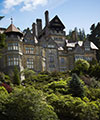May
Newcastle students translate Cragside story for overseas visitors

The wonders of Cragside are now accessible to an even wider audience, thanks to students at Newcastle University.
More than 30 final year students from the School of Modern Languages have translated the official guide to the 19th Century house into Spanish, German, Portuguese and Japanese ahead of the main visitor season. It is the first time that visitor information has been made available in these languages.
The project came about as a result of a trip to Cragside by Angela Uribe de Kellett, lecturer in the School of Modern Languages, as she explains: “When I visited Cragside, it struck me that guides in a broader range of languages could really enhance a visit to this wonderful house and estate for overseas visitors.
“Cragside has such an enthralling history and has always had strong international links so it seemed a good opportunity for our students – some of whom are from overseas themselves – to gain first-hand knowledge of the story of Cragside and Lord Armstrong while practicing their translation skills.”
The work is part of the Real Translation Project, a programme run by a group of language teachers and student volunteers from the School of Modern Languages. Working together, they help charitable and community organisations translate documents into various languages taught at the University, such as Spanish, French, German, Portuguese, Chinese and Japanese.
The project got underway with the students visiting Cragside (pictured) to better understand the history of the house and estate, its position as test-bed for many of Lord Armstrong’s innovations and the setting for his extensive arts and crafts collection so that they could produce more accurate translations.
One of the students involved in the project is Jaime Frances Martínez, an Erasmus student from Spain, who said: “The translation of the Cragside guide has unquestionably been an enriching experience, since it has not only widened our general knowledge and language skills, but also given us the opportunity to learn from a real translation task while doing charity work”.
Another student, Isabel Gillet, said: “Taking part in the Cragside translation project has been a really positive experience. It’s increased my knowledge and awareness of this important cultural heritage site, and also helped my own personal development in terms of conducting translations and working as a team, all of which has given me valuable experience.
“I really hope visitors to Cragside enjoy their visit as much as we enjoyed translating the guides.”
Cragside’s Property Curator, Andrew Sawyer added: “Lord Armstrong was a great supporter of education and contributed substantial sums in the founding of the College of Physical Science, which later became Armstrong College and then Newcastle University, so he would be delighted that students from the same university have now produced translated guides for visitors to the house and country estate he loved so much.”
Cragside has a long history of welcoming overseas visitors. Lord and Lady Armstrong entertained guests from all over the world, due to the trading links with Lord Armstrong’s Elswick works. A glance down the list of ships launched from the Elswick Shipyard alone conveys the global market place Lord Armstrong moved in: Austro-Hungarian, Chinese, Spanish, Italian, Australian, Argentinian, Brazilian, Chilean, Portuguese, Norwegian, American and Japanese ships all sailed out of the Tyne destined for the countries which had ordered them.
The house has a particularly strong connection with Japan - many of Lord Armstrong’s Japanese customers, naval officers and government ministers visited Cragside. Japanese royalty were also among the guests – a tradition that continued well into the 20th Century. The Japanese Room at Cragside still contains gifts associated with the Marquis and Marchioness Yorisada Tokugawa, the uncle and aunt to the Empress of Japan who visited several times, while the present Emperor visited Cragside in 1953, followed by his son, the Crown Prince, in 1991.
Image courtesy of the National Trust.
published on: 14 May 2015
